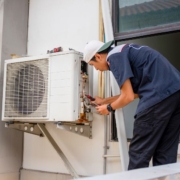How to Change AC Filter
The air conditioning (AC) filter is a vital component of any cooling system. It traps dust, pollen, and other airborne particles, preventing them from circulating through the air and accumulating in the system. A clogged or dirty filter can reduce airflow, decrease efficiency, and strain the AC system, leading to higher energy bills and potential mechanical issues. Changing the AC filter regularly ensures clean air, proper system performance, and energy efficiency.
Understanding AC Filters
AC filters are typically made from fiberglass, pleated paper, or synthetic materials. They are designed to capture particles of various sizes, including dust, pet dander, and mold spores. The filter’s MERV rating (Minimum Efficiency Reporting Value) indicates its effectiveness. Higher MERV ratings capture smaller particles but may restrict airflow more than lower-rated filters.
Residential AC systems commonly use filters sized 16×20 inches or 20×25 inches, but sizes vary depending on the unit. Filters can be disposable or reusable. Disposable filters are replaced entirely, while reusable filters require cleaning and reinstallation.
Signs That an AC Filter Needs Replacement
A filter should be replaced when it becomes visibly dirty, clogged, or dusty. Reduced airflow from vents, unusual odors, or increased energy consumption may also indicate a clogged filter. For most residential systems, replacing the filter every 30 to 90 days is recommended, but frequency may vary depending on system usage, household size, and presence of pets.
How to Change an AC Filter
Begin by turning off the AC system to prevent unfiltered air from circulating during the replacement process. Locate the filter compartment, usually in the return air duct or the air handler unit. Carefully remove the old filter, noting the direction of airflow indicated by an arrow on the filter frame.
Select a replacement filter that matches the size and MERV rating of the original. Insert the new filter with the airflow arrow pointing in the correct direction, usually toward the blower fan. Ensure the filter fits snugly without gaps around the edges. Close the filter compartment or door securely and turn the system back on.
For reusable filters, remove the filter and clean it with warm water or a vacuum according to the manufacturer’s instructions. Allow it to dry completely before reinstalling it. Regular cleaning prevents dust buildup and maintains system efficiency.
Safety and Maintenance Tips
Always ensure the AC system is powered off before removing or replacing the filter. Avoid forcing the filter into a compartment, as this can damage the frame or unit. Keeping spare filters on hand helps maintain a consistent replacement schedule.
Routine maintenance of the AC system, including checking coils, drains, and blower components, complements filter replacement. Inspecting the filter monthly during heavy use periods ensures optimal air quality and energy efficiency.
FAQ
How often should I change my AC filter?
Typically every 30 to 90 days, depending on usage, household environment, and presence of pets.
Can a dirty filter damage my AC system?
Yes. A clogged filter reduces airflow, causing the system to work harder, which can strain the compressor, blower motor, and other components.
Can I use a higher MERV filter than recommended?
Higher MERV filters capture smaller particles but may restrict airflow. Check your AC system specifications before upgrading.
Are reusable filters effective?
Yes, if cleaned regularly according to the manufacturer’s instructions. They provide long-term savings and reduce waste.
What should I do if my AC still blows weak air after changing the filter?
Check for blocked vents, dirty coils, or issues with the blower motor. Persistent problems may require a professional inspection.
Conclusion
Changing the AC filter is a simple yet crucial task for maintaining air quality, system efficiency, and energy savings. Filters capture dust, pollen, and other particles, preventing them from circulating and clogging the system. Regular replacement, typically every 30 to 90 days, helps maintain optimal airflow and cooling performance. Understanding filter types, sizes, and MERV ratings ensures the correct choice for your AC unit. Whether using disposable or reusable filters, proper installation and routine maintenance contribute to a longer-lasting and more efficient air conditioning system.

